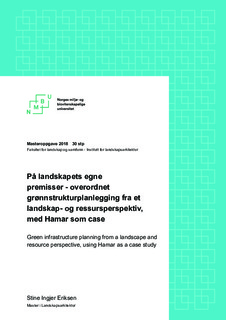| dc.contributor.advisor | Clemetsen, Morten | |
| dc.contributor.advisor | Ødegård, Ingrid Merete | |
| dc.contributor.author | Eriksen, Stine Ingjer | |
| dc.coverage.spatial | Norway, Hamar | nb_NO |
| dc.date.accessioned | 2019-01-29T11:38:47Z | |
| dc.date.available | 2019-01-29T11:38:47Z | |
| dc.date.issued | 2018 | |
| dc.identifier.uri | http://hdl.handle.net/11250/2582789 | |
| dc.description.abstract | “Enhver by ligger i et naturgitt landskap som er spesielt for byen og som preger den”, skrev arkitekt og byplanlegger Erik Lorange i 1984. I dagens samfunn er likevel tendensen at byen utvikles til å bli et stadig mer selvstendig system, avgrenset fra sine omgivelser. Byutviklingen har ført til fortetting og transformasjon av byen, som særlig har gått på bekostning av det opprinnelige naturgrunnlaget og de ulike synergiene som foreligger mellom landskap og by.
Bynaturen har samtidig en viktig rolle og funksjon i bymiljøet, knyttet til klimatilpasning, naturmangfold, stedegenhet og relasjonen mellom mennesket og natur. Denne oppgaven undersøker hvor vidt ulike synergier mellom by og landskap kan reetableres og styrkes, ved landskapet som førende premiss for den overordnede planleggingen. Målet er å gi naturen en tydeligere plass og funksjon i byen, med grønne strukturers naturlige potensial til å håndtere ulike klima- og samfunnsutfordringer lagt til grunn.
Oppgaven foreslår et grunnlag bestående av ulike utformingsprinsipper, som skal legge tydelige føringer for planleggingen. Grunnlaget er ment som et verktøy på kommunenivå, for å oppnå en flerfunksjonell overordnet grønnstruktur, med tydelige verdier og funksjoner.
Prinsippene utprøves gjennom en caseoppgave i Hamar. Gjennom tre ulike plannivåer vises et overordnet forslag til hvordan grønnstrukturen kan bli et førende middel for arealplanleggingen i byen, og gjenvinne sin plass i bymiljøet. I slutten av oppgaven vurderes prinsippene, på bakgrunn av erfaringer fra arbeidet med caseoppgaven. | nb_NO |
| dc.description.abstract | “Every city lies in a historical landscape that is special for the city environment and characterizes it” wrote architect and urban planner Erik Lorange in 1984. In today’s society, however, the city has evolved into an increasingly independent system, bound by its natural surroundings. This is especially at the expense of the original natural foundation and various synergies that exist between landscape and city.
At the same time, urban nature has an important role and function, in regards to climate adaptation, natural diversity and the relation between human and nature. This thesis investigates how far the synergy between city and landscape can be re-established and strengthened, using the landscape as the premier tool for overall planning. The goal is to assign urban nature a stronger place and function in the city, due to the natural potential of green structures to handle different climate and societal challenges.
The thesis proposes as base of principles, that should be the method to achieve a high quality in the overall planning of green infrastructure. This basic is intended to be used as a tool at the municipal level,, in order to achieve a resource-based and functional green infrastructure.
The principles are shown through a case study in Hamar, Norway, and are further considered, based on experience achieved through the case study. | nb_NO |
| dc.language.iso | nob | nb_NO |
| dc.publisher | Norwegian University of Life Sciences, Ås | nb_NO |
| dc.rights | Attribution-NonCommercial-NoDerivatives 4.0 Internasjonal | * |
| dc.rights.uri | http://creativecommons.org/licenses/by-nc-nd/4.0/deed.no | * |
| dc.subject | Byutvikling | nb_NO |
| dc.subject | Landskapsarkitektur | nb_NO |
| dc.subject | Urban planning | nb_NO |
| dc.subject | Landscaping | nb_NO |
| dc.title | På landskapets egne premisser : overordnet grønnstrukturplanlegging fra et landskap- og ressursperspektiv : med Hamar som case | nb_NO |
| dc.title.alternative | Green infrastructure planning from a landscape and resource perspective : using Hamar as a case study | nb_NO |
| dc.type | Master thesis | nb_NO |
| dc.description.localcode | M-LA | nb_NO |

